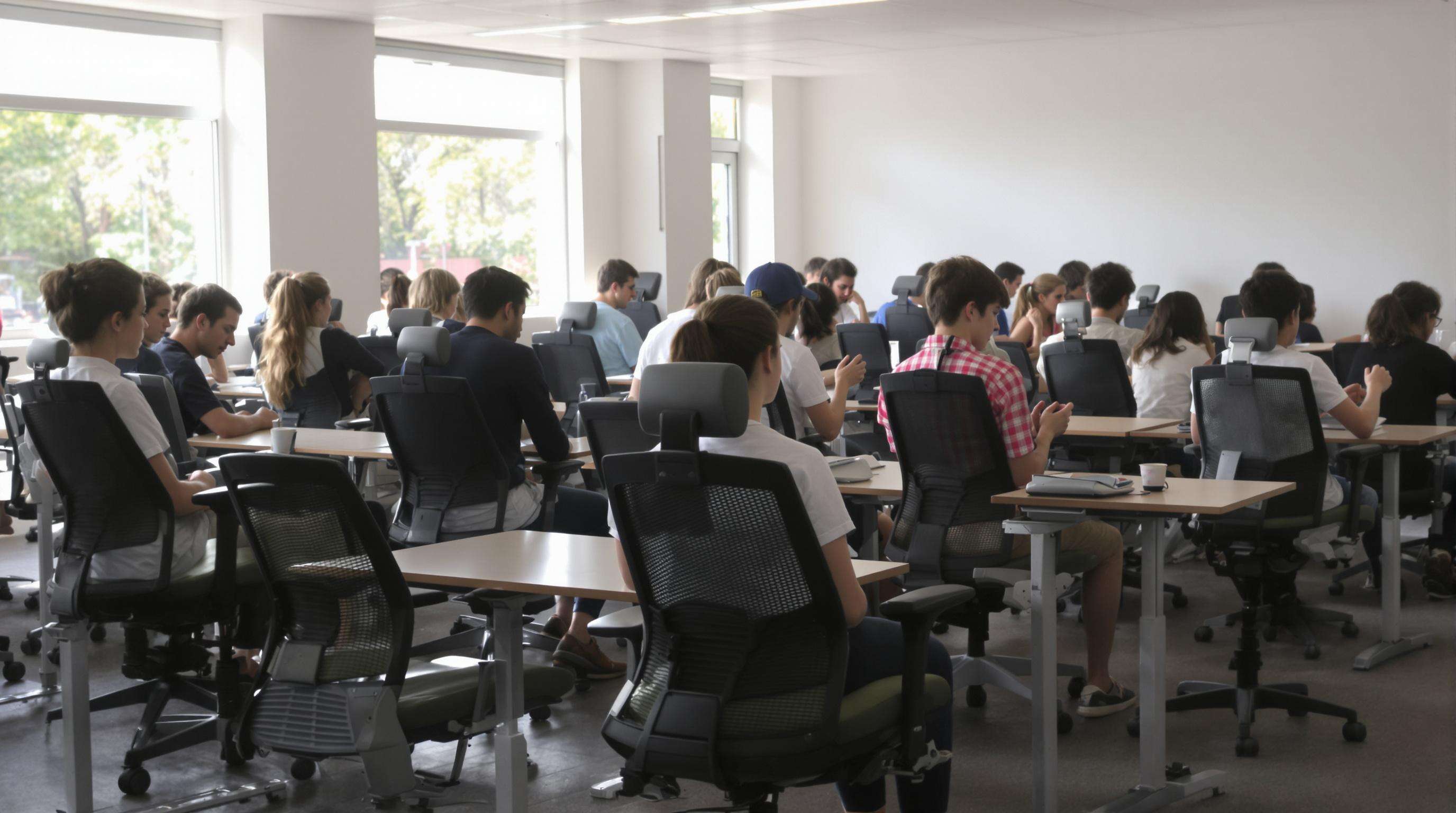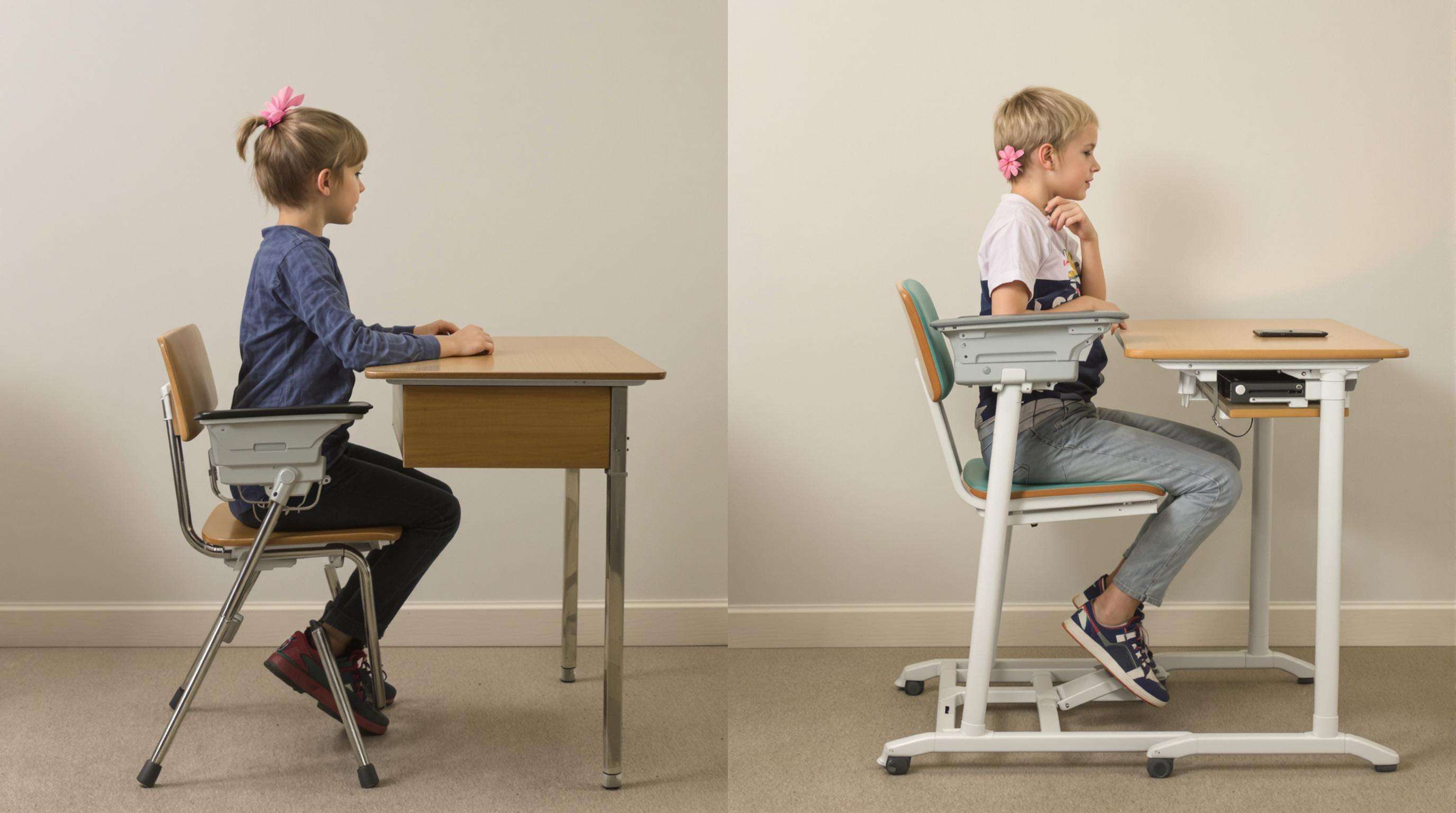How Study Chairs Impact Student Focus and Productivity
Ergonomic Design and Cognitive Focus
How Ergonomic Alignment Supports Mental Focus
When student desks and chairs are properly aligned, it actually helps kids think better because their bodies aren't fighting against them. Studies have found that when furniture matches a student's body measurements, they can concentrate about 27 percent longer than when sitting in uncomfortable setups according to research from the Physical & Cognitive Ergonomics Study last year. The reason? Better circulation throughout the body and less tension in muscles while sitting down. These small improvements make a big difference when students need to stay focused during long classroom sessions.
Research Findings on Posture and Attention Span
A 2021 Journal of Environmental Psychology study revealed students using adjustable-height chairs maintained upright posture 38% longer than peers with fixed chairs. Extended upright positioning correlated with:
- 19% faster problem-solving times
- 22% better recall accuracy
- 31% reduction in self-reported mental fatigue
These findings underscore the direct link between postural stability and cognitive efficiency.
The Role of Lumbar Support in Reducing Cognitive Fatigue
Modern ergonomic chairs featuring dynamic lumbar systems reduced mid-session concentration lapses by 41% (Applied Ergonomics, 2023). Proper lumbar alignment prevents energy-draining postural compensation movements, preserving mental resources for academic tasks rather than managing discomfort.
Trend Analysis: Shift Toward Dynamic Seating in Modern Classrooms
Over 70% of US schools adopted dynamic seating options like wobble stools and standing desk converters since 2022. These adaptive student desk and chair configurations show promise for kinetic learners, with pilot programs reporting 15–20% improvements in engagement metrics during lengthy STEM classes.
Physical Comfort and Learning Performance

Linking Physical Comfort to Information Retention
Research from the Educational Ergonomics Journal back in 2022 showed that students who feel physically uncomfortable retain about 18% less information than those sitting in proper ergonomic chairs. When someone's body is hurting, their brain actually works harder on the pain signals rather than absorbing what's being taught. Studies indicate it spends around 27% more energy dealing with discomfort than learning new stuff. More recently, a big study looking at 47 different classrooms in 2023 found something interesting too. Schools that had adjustable desks and chairs saw a drop of about 34% in those little fidgety moments during lessons. Teachers noticed this translated into better scores on quizzes across the board.
Physiological Markers of Comfort: Heart Rate and Cortisol Levels
Modern biometric studies reveal:
| Metric | Unsupported Chairs | Ergonomic Chairs | Change |
|---|---|---|---|
| Resting Heart Rate | 82 bpm | 76 bpm | -7.3% |
| Cortisol Levels | 4.3 µg/dL | 3.2 µg/dL | -25.6% |
(Source: Classroom Physiology Study 2023, n=1,200 students)
Lower cortisol levels directly correlate with increased working memory capacity, particularly during standardized testing scenarios requiring sustained focus.
Classroom Trial: Improved Test Scores With Upgraded Student Desk and Chair Setups
A year-long district-wide trial replacing traditional furniture with ergonomic student desk and chair combinations demonstrated:
- 14% higher math proficiency scores
- 22% reduction in posture-related absenteeism
- 19% faster concept mastery in science labs
Post-trial surveys revealed 68% of students reported increased ability to maintain attention during 90-minute class periods. Schools implementing phased classroom upgrades saw 2.3x greater academic improvement compared to control groups using outdated furniture.
Long-Term Postural Health and Ergonomic Development

Long-term effects of poor seating on spinal health
When kids sit at desks and chairs that don't fit them properly for long periods, their spines can start to develop problems. A recent 2024 study on classroom ergonomics showed something pretty alarming: around 8 out of 10 students sitting at mismatched furniture started showing noticeable posture issues after just three school years. Many classrooms still use those old fixed height chairs which basically lock kids into one position all day. This puts extra stress on growing bones, especially during those rapid growth phases when kids are getting taller fast. The bad news is these poor sitting habits tend to stick around into adult life too. Looking at the numbers, researchers noticed teens who spent most of their time in non adjustable seats had about triple the risk of developing chronic lower back pain by the time they reached thirty years old.
Design principles for age-appropriate student desk and chair configurations
Effective ergonomic development requires three key adjustments:
- Seat depth: Should leave 2–3 fingers’ space between knee and seat edge (prevents sciatic nerve compression)
- Backrest angle: 95°â105° tilt reduces disc pressure by 35% compared to rigid 90° designs
- Height adjustability: Annual growth spurts (averaging 6 cm/year in adolescents) demand 7-stage lift mechanisms
Anthropometric data from 12,000 students confirms that desks accommodating 5th–90th percentile limb lengths reduce spinal asymmetry by 61% during writing tasks. Schools implementing phased replacement cycles (upgrading furniture every 4 years) report 89% fewer referrals to pediatric orthopedists.
Emotional Well-Being and Seating Support
Student desk and chair configurations directly shape emotional well-being through tactile and postural feedback mechanisms. Researchers at the University of Michigan Ergonomics Center (2023) found that chairs with adjustable lumbar support reduced self-reported classroom stress by 31% compared to static seats, demonstrating how physical support systems influence emotional regulation.
How Supportive Chairs Influence Emotional Regulation
Proper pelvic stabilization enables diaphragmatic breathing patterns critical for managing cortisol levels. A 4-month classroom trial showed students using chairs with dynamic seat pans displayed 22% lower anxiety markers during exams (Journal of Educational Ergonomics, 2024).
Survey Data: Student Self-Reports on Seating-Related Anxiety
| Stress Indicator | Rigid Chairs | Ergonomic Chairs |
|---|---|---|
| Neck stiffness | 68% | 29% |
| Task avoidance | 41% | 17% |
| Mood swings | 33% | 12% |
Data from 2,100 high school students reveals 54% associate poorly designed student desk and chair setups with heightened test anxiety (National Education Association, 2023).
Controversy Analysis: Are Cushioned Seats Overrated for Emotional Comfort?
While 82% of students initially prefer plush seating in classroom trials, 70% switch to firmer ergonomic options within 3 weeks due to better focus. Over-softening disrupts the proprioceptive feedback needed for sustained mental engagement, creating a comfort-focus tradeoff requiring balanced design solutions.
Academic Outcomes and Strategic Classroom Upgrades
Comparative Analysis: Traditional Benches vs. Ergonomic Study Chairs
Classrooms using ergonomic study chairs demonstrate 17% higher sustained focus rates compared to those with traditional benches, according to a classroom posture analysis spanning 42 schools. Key advantages of student desk and chair systems with adjustable features include:
- 23% reduction in fidgeting during lectures
- 34% improvement in writing task completion speed
- 19% longer engagement in collaborative activities
These outcomes align with neuroscience findings showing proper hip and knee alignment enhances blood flow to the prefrontal cortex by 12% (Neurological Research Quarterly, 2023).
Meta-Study: Correlation Between Seating Quality and Academic Performance
Analysis of 37 global studies reveals classrooms with ergonomic upgrades achieve measurable academic improvements:
| Metric | Traditional Seating | Ergonomic Seating |
|---|---|---|
| Test Score Variance | ±22% | ±9% |
| Homework Completion | 71% | 89% |
| Class Participation | 58% | 83% |
The data suggests proper lumbar support and seat depth adjustments reduce cognitive fatigue spikes by 41% during afternoon classes (Educational Ergonomics Review, 2024).
Strategy: Integrating Student Desk and Chair Upgrades Into School Improvement Plans
Forward-thinking districts now allocate 15–20% of facility budgets to student desk and chair ergonomics, recognizing the $7:1 ROI through improved academic performance and reduced injury claims. Successful implementation requires:
- Teacher training on adjustable feature optimization
- Progressive rollout prioritizing STEM and writing-intensive courses
- Post-implementation posture audits every 18 months
A 2024 pilot program demonstrated schools following this framework achieved 2.4x faster adoption rates compared to piecemeal approaches, with 92% staff reporting observable concentration improvements.
FAQ
What benefits do ergonomic student desks and chairs provide?
Ergonomic furniture supports better posture, enhances blood circulation, and increases concentration, leading to improved academic performance and reduced physical discomfort.
Why are ergonomic chairs recommended over traditional seating in classrooms?
Ergonomic chairs have adjustable features that aid in better posture, reduce physical strain, and enhance cognitive focus, unlike traditional, fixed chairs that can cause discomfort and long-term health issues.
How do seating arrangements affect students’ emotional well-being?
Supportive seating configurations can significantly reduce stress and anxiety levels by ensuring proper posture and comfort, which affects students’ emotional regulation and overall well-being.
What is the connection between postural stability and cognitive function?
Proper postural alignment prevents unnecessary energy expenditure on physical discomfort, allowing students to allocate mental resources to cognitive tasks, thereby boosting focus, retention, and problem-solving abilities.


